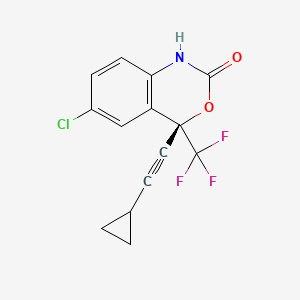D0045 | Efavirenz
J
J05AR11 Lamivudine, tenofovir disoproxil and efavirenz
[J05AR] Antivirals for treatment of HIV infections, combinations
[J05A] DIRECT ACTING ANTIVIRALS
[J05] ANTIVIRALS FOR SYSTEMIC USE
[J] Antiinfectives for systemic use
J05AR06 Emtricitabine, tenofovir disoproxil and efavirenz
[J05AR] Antivirals for treatment of HIV infections, combinations
[J05A] DIRECT ACTING ANTIVIRALS
[J05] ANTIVIRALS FOR SYSTEMIC USE
[J] Antiinfectives for systemic use
J05AG03 Efavirenz
[J05AG] Non-nucleoside reverse transcriptase inhibitors
[J05A] DIRECT ACTING ANTIVIRALS
[J05] ANTIVIRALS FOR SYSTEMIC USE
[J] Antiinfectives for systemic use
| Toxicity | Dose | Time | Species | Model | Method | Action | Positive criterion | Reference |
|---|---|---|---|---|---|---|---|---|
| RESPIRATION | 197 | |||||||
| ROS PRODUCTION | increase | 197 | ||||||
| Pictogram | Signal | Statements | Precautionary Statement Codes |
|---|---|---|---|
   |
Danger |
Aggregated GHS information provided by 87 companies from 11 notifications to the ECHA C&L Inventory. Each notification may be associated with multiple companies. H302 (51.72%): Harmful if swallowed [Warning Acute toxicity, oral] H319 (48.28%): Causes serious eye irritation [Warning Serious eye damage/eye irritation] H360 (48.28%): May damage fertility or the unborn child [Danger Reproductive toxicity] H372 (42.53%): Causes damage to organs through prolonged or repeated exposure [Danger Specific target organ toxicity, repeated exposure] H400 (91.95%): Very toxic to aquatic life [Warning Hazardous to the aquatic environment, acute hazard] H410 (94.25%): Very toxic to aquatic life with long lasting effects [Warning Hazardous to the aquatic environment, long-term hazard] Information may vary between notifications depending on impurities, additives, and other factors. The percentage value in parenthesis indicates the notified classification ratio from companies that provide hazard codes. Only hazard codes with percentage values above 10% are shown. |
P201, P202, P260, P264, P270, P273, P280, P281, P301+P312, P305+P351+P338, P308+P313, P314, P330, P337+P313, P391, P405, and P501; (The corresponding statement to each P-code can be found at the GHS Classification page.) |
| (-)-6-CHLORO-4-CYCLOPROPYLETHYNYL-4-TRIFLUOROMETHYL-1,4-DIHYDRO-2H-3,1-BENZOXAZIN-2-ONE | (4S)-6-Chloro-4-(2-cyclopropylethynyl)-1,4-dihydro-4-(trifluoromethyl)-2H-3,1-benzoxazin-2-one | (4S)-6-Chloro-4-(cyclopropylethynyl)-1,4-dihydro-4-(trifluoromethyl)-2H-3,1-benzoxazin-2-one |
| (4S)-6-chloranyl-4-(2-cyclopropylethynyl)-4-(trifluoromethyl)-1H-3,1-benzoxazin-2-one | (4S)-6-chloro-4-(2-cyclopropylethynyl)-4-(trifluoromethyl)-1H-3,1-benzoxazin-2-one | (4S)-6-chloro-4-(2-cyclopropylethynyl)-4-(trifluoromethyl)-2,4-dihydro-1H-3,1-benzoxazin-2-one |
| (4S)-6-chloro-4-(cyclopropylethynyl)-4-(trifluoromethyl)-1,4-dihydro-2H-3,1-benzoxazin-2-one | (S)-6-CHLORO-4-(CYCLOPROPYLETHYNYL)-4-(TRIFLUOROMETHYL)-1H-BENZO[D][1,3]OXAZIN-2(4H)-ONE | (S)-6-Chloro-4-(cyclopropyl-ethynyl)-1,4-dihydro-4-(trifluoromethyl)-2H-3,1-benzoxazine-2-one |
| (S)-6-Chloro-4-(cyclopropylethynyl)-1,4-dihydro-4-(trifluoromethyl)-2H-3,1-benzoxazin-2-one | (S)-6-Chloro-4-cyclopropylethynyl-4-trifluoromethyl-1,4-dihydro-benzo[d][1,3]oxazin-2-one | (S)-6-chloro-4-(cyclopropylethynyl)-4-(trifluoromethyl)-1,4-dihydro-2H-3,1-ben zoxazin-2-one |
| (S)-6-chloro-4-(cyclopropylethynyl)-4-(trifluoromethyl)-1,4-dihydro-2H-3,1-benzoxazin-2-one | (S)-6-chloro-4-(cyclopropylethynyl)-4-(trifluoromethyl)-1,4-dihydro-2H-benzo[d][1,3]oxazin-2-one | (S)-Efavirenz |
| (s)-6-chloro-4-cyclopropylethynyl-4-trifluoromethyl-1,4-dihydro-2H-3,1-benzoxazin-2-one | 154598-52-4 | 1ikv |
| 1ikw | 2H-3, 6-chloro-4-(cyclopropylethynyl)-1,4-dihydro-4-(trifluoromethyl)-, (4S)- | 2H-3,1-Benzoxazin-2-one, 6-chloro-4-(cyclopropylethynyl)-1,4-dihydro-4-(trifluoromethyl)-, (4S)- |
| 598E524 | 6-chloro-4-(2-cyclopropyl-1-ethynyl)-4-trifluoromethyl-(4S)-1,4-dihydro-2H-benzo[d][1,3]oxazin-2-one | A809555 |
| AB00639956-06 | AB00639956-08 | AB21723 |
| AC-25006 | ACM154801748 | AK323634 |
| AKOS015894951 | AOB2950 | API0002525 |
| BCP27719 | BCP9000636 | BCPP000245 |
| BDBM2483 | BIDD:GT0383 | C-19450 |
| C08088 | C14H9ClF3NO2 | CAS-154598-52-4 |
| CC-27439 | CCG-101011 | CHEBI:119486 |
| CHEMBL223228 | CPD000466351 | CS-2154 |
| CTK8E9137 | D00896 | DB00625 |
| DL-535 | DMP 266 | DMP-266 |
| DMP-266 | DSSTox_CID_26029 | DSSTox_GSID_46029 |
| DSSTox_RID_81298 | DTXSID9046029 | E0997 |
| EFV | EFV & IFNL1 | EFV & IFNL2 |
| EFV & IFNL3 | EFV & IL-28A | EFV & IL-28B |
| EFV & IL-29 | EFV & Interferon lambda-1 | EFV & Interferon lambda-2 |
| EFV & Interferon lambda-3 | EFV & Interleukin 28A | EFV & Interleukin 28B |
| EFV & Interleukin 29 | EFV & PLGA | Efavirenz |
| Efavirenz & IFNL1 | Efavirenz & IFNL2 | Efavirenz & IFNL3 |
| Efavirenz & IL-28A | Efavirenz & IL-28B | Efavirenz & IL-29 |
| Efavirenz & Interferon lambda-1 | Efavirenz & Interferon lambda-2 | Efavirenz & Interferon lambda-3 |
| Efavirenz & Interleukin 28A | Efavirenz & Interleukin 28B | Efavirenz & Interleukin 29 |
| Efavirenz & PLGA | Efavirenz & Poly-lactide-co-glycolide | Efavirenz (JAN/INN) |
| Efavirenz [USP:INN:BAN] | Efavirenz solution, 1.0 mg/mL in acetonitrile, certified reference material | Efavirenz, (S) |
| Efavirenz, >=98% (HPLC) | Efavirenz, United States Pharmacopeia (USP) Reference Standard | Efavirenzum |
| Eravirenz | FT-0625647 | GP6354 |
| HMS2051J08 | HMS2090N16 | HMS3393J08 |
| HMS3713M14 | HSDB 7163 | HY-10572 |
| J-520431 | JE6H2O27P8 | KS-00000ZEH |
| KS-00002WWM | KS-5380 | L 743726 |
| L-743,726 | L-743725 | L-743726 |
| LS-173464 | MFCD05662344 | MLS000759465 |
| MLS001424087 | Met-SDF-1.beta. & Efavirenz | Met-Stromal Cell-derived Factor-1.beta. (Human) & Efavirenz |
| NC00261 | NCGC00159337-02 | NCGC00159337-04 |
| NCGC00271713-05 | NSC-742403 | NSC742403 |
| PubChem5812 | Q422645 | RTX-012332 |
| SAM001246667 | SC-46515 | SCHEMBL37762 |
| SMR000466351 | SR-01000759360 | SR-01000759360-4 |
| SR-01000759360-5 | Stocrin | Strocin (TM) |
| Sustiva | Sustiva (TM) | Sustiva (TN) |
| Tox21_111582 | Tox21_111582_1 | UNII-JE6H2O27P8 |
| XPOQHMRABVBWPR-ZDUSSCGKSA-N | Z2186909878 | ZINC2020233 |
| efavirenz | efavirenz, (S)-isomer | s4685 |

